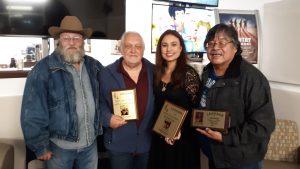Red Bow doc hits the mark

Friends, fans and family of Buddy Red Bow packed the studio of South Dakota Public Broadcasting last week for a pre-screening of the documentary Red Bow. Williams and Bald Eagle talked about their good friend following the viewing. (Photo by Richie Richards)
RAPID CITY – When the documentary “Red Bow” ended last week in Rapid City, those in attendance cheered loudly for their country music hero.
On Wednesday, Oct. 2, South Dakota Public Broadcasting held a pre-screening of Red Bow and the studio space was packed with guests. Many in the crowd were close friends and relatives, while others were admirers of the music legend.
The film follows the life of Buddy Red Bow (Oglala Lakota), since the time of him being left on the steps of a reservation church, to his times of singing on the tables in local bars as a boy, right up to becoming a legend in Indian Country. His life is similar to the lives of many Native American people, especially the Lakota.
His lyrics capture the essence of a person having to walk in two worlds; a white man world and a spiritual world. The documentary captured this duality throughout. The persons interviewed gave great descriptions of Red Bow and his life during the period in which he lived and sang from. This era was a transitional period for this generation and Red Bow’s music spoke directly to the ones longing for the old days and old ways.
The event was one of a few pre-screenings leading up to the Oct. 14 premiere on SDPB-TV. Filmmaker, Lee Michael Strubinger, was on hand to thank Buddy Red Bow’s family and friends. Several of the persons interviewed in the documentary were present as well, including Tim Giago, Donnie Williams, Leo Bald Eagle, and Red Bow’s daughter, Stardust Red Bow.
“I think the documentary is a great depiction of my dad’s musical life. I was actively involved in the production. My dad’s producer, Dik Darnell, and I had final creative approval,” said Stardust Red Bow. “There are many stories one could tell about my dad, and I think focusing on his music was smart given the time allotted for the documentary.”
A major influence in Buddy Red Bow’s life was his spirituality and the friendship he had with Lakota Chief Fools Crow. Throughout the film, Fools Crow’s influence and guidance was discussed. Red Bow credited his balance to his relationship with his creator and the humble teachings of the Lakota leader. Many of the scenes where Red Bow talked about Fools Crow and then sang some of his songs were from a television show filmed in 1977 at the KEVN-TV station on a show called The First Americans hosted by Oglala Lakota newspaperman, Tim Giago.
“He wrote about the past: Lakota history, myths, and spiritual beliefs. He told stories, which were passed down to him from Lakota elders. My dad listened to the stories they told and understood their importance. He learned extensively from Chief Fools Crow,” said Red Bow.
The music of Buddy Red Bow spoke about love; love for others, love for self and love for the spiritual world. His lyrics are as relevant today as they were decades ago when they were written. His booming voice often spoke like thunder during his songs and interviews from the time period. “My dad’s music is timeless, because the history and spiritual beliefs of the Lakota haven’t changed. Humans continue to struggle with finding ‘quiet heart’, as Trixie Koontz calls it in her book Bliss to You,” said Stardust Red Bow. “They allow negative thoughts, pain, grief, and heartache to consume them rather than letting go, being of service to others, and allowing beauty and contentment into their lives.”
Red Bow said her two favorite songs of her father’s were ‘Thunderbird’ and ‘My Friend the Buffalo’. ‘Thunderbird’ taps into her own vivid imagination. “When I hear ‘Thunderbird’, I visualize a great Incan condor-esque bird flying to heaven through a thunderstorm and outer space. I have a strong spiritual belief in heaven as did my dad. As a child, I loved stories about the Inca and other ancient societies. I like ‘My Friend the Buffalo’ because animals deserve to be treated with respect and love,” she said.
During the pre-screening, persons could be heard quietly singing along to the spiritual lyrics, while others privately wept to the memories of their dear friend and relative. Band mates told stories of their adventures of places like White Clay, Neb., and traveling Europe with Buddy Red Bow during his hay day. The rowdy bars and racism of the day was discussed, and Red Bow’s songs found a way to unite red and white worlds. He was a funny man with a serious talent whose music did not quite make it into mainstream society, but could very easily have been played right along with music by Willie Nelson and John Denver on radio stations across the country.
“The past shapes us but doesn’t define us. Cultural traditions and spiritual practices help people navigate their lives as much now as they did centuries ago. Educating people about Lakota history, traditions, and beliefs is as needed today as it was when my dad was alive. There are positive aspects to every culture, and we can all learn from each other. My dad was not a divisive person, and our society could benefit from more understanding and acceptance,” said Stardust Red Bow.
The filmmakers worked closely with Red Bow’s family and friends to capture his spirit. There are stories of humor, pain, triumph, spirituality, survival and reemergence told throughout the film by those who knew Buddy Red Bow best. The film takes viewers on a journey to the spirit world.
(Contact Native Sun News Today Correspondent Richie Richards at richie4175@gmail.com)
